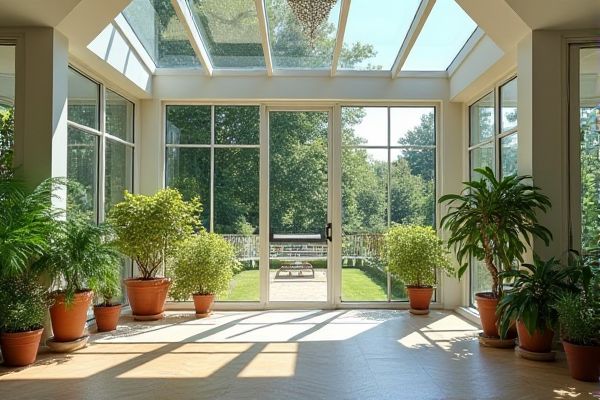
Acrylic windows offer superior impact resistance and better insulation compared to traditional glass windows, making them an excellent choice for sunrooms that require durability and energy efficiency. Discover which option best suits Your sunroom by exploring the detailed comparison in the rest of this article.
Table of Comparison
| Feature | Acrylic Windows | Glass Windows |
|---|---|---|
| Material | Poly(methyl methacrylate) (PMMA) | Silica-based Glass |
| Weight | Lightweight (50% lighter than glass) | Heavier |
| Clarity | High optical clarity, UV-resistant coatings possible | Crystal clear, natural transparency |
| Durability | Impact-resistant, less prone to shattering | Brittle, prone to cracking & shattering |
| Thermal Insulation | Better insulation, lower thermal conductivity | Moderate insulation, higher heat transfer |
| Scratch Resistance | Lower, scratches easier | Higher, more scratch-resistant |
| Cost | Generally less expensive | Typically higher initial cost |
| Maintenance | Requires careful cleaning to avoid scratches | Simple cleaning, more durable surface |
| UV Protection | Can include UV-blocking additives | Natural UV transmission unless coated |
| Lifespan | 10-15 years with proper care | 20+ years with proper maintenance |
| Use Case | Ideal for lightweight, impact-resistant sunroom windows | Preferred for high clarity and traditional aesthetics |
Introduction to Sunroom Window Choices
Acrylic windows offer enhanced impact resistance and better insulation compared to traditional glass windows, making them a durable and energy-efficient choice for sunrooms. Glass windows provide superior clarity and scratch resistance, contributing to a pristine and visually appealing sunroom environment. Choosing between acrylic and glass windows for a sunroom involves balancing factors like durability, thermal performance, and aesthetic preferences.
Understanding Acrylic Windows: Features and Composition
Acrylic windows in sunrooms are crafted from polymethyl methacrylate (PMMA), a lightweight and durable plastic known for its high impact resistance and excellent clarity. These windows offer superior insulation and UV resistance compared to traditional glass, reducing heat transfer and preventing fading of interior furnishings. Your choice of acrylic can enhance energy efficiency and safety while maintaining clear, vibrant views.
Glass Windows: Traditional Option Explained
Glass windows remain the traditional choice for sunrooms due to their clarity, durability, and superior scratch resistance compared to acrylic. They offer excellent natural light transmission and maintain their appearance over time without yellowing. Your sunroom can benefit from glass windows' ability to provide a classic aesthetic while ensuring long-term performance and easy maintenance.
Energy Efficiency: Acrylic vs Glass Performance
Acrylic windows offer superior energy efficiency compared to traditional glass windows in sunrooms due to their better insulation properties and lower thermal conductivity. Acrylic panels reduce heat transfer, helping maintain indoor temperatures and lowering energy costs for heating and cooling. Glass windows, while providing clarity and durability, generally have higher thermal conductivity, resulting in more heat loss or gain.
Durability and Impact Resistance Comparison
Acrylic windows offer superior impact resistance compared to traditional glass windows in sunrooms, providing better protection against hail, debris, and accidental impacts. They are less prone to shattering, making them more durable and safer in high-traffic or storm-prone areas. While glass windows can be more scratch-resistant, acrylic's flexibility and toughness enhance long-term durability under various environmental stresses.
Clarity and Light Transmission Differences
Acrylic windows offer higher light transmission, typically around 92%, compared to standard glass windows which transmit about 80-90% of visible light. Acrylic provides greater optical clarity with less distortion, enhancing the brightness and view in sunrooms. Glass windows, while durable, can slightly reduce light transmission due to thickness and coatings, affecting overall clarity.
Weight, Installation, and Structural Considerations
Acrylic windows are significantly lighter than traditional glass windows, reducing the overall weight load on sunroom structures and simplifying installation due to their ease of handling and cutting. Their flexibility offers better resistance to impacts and minor structural shifts, whereas glass windows require stronger framing systems to support their heavier weight and rigidity. Installation of acrylic windows often involves fewer tools and less labor, making them a cost-effective choice for reinforcing sunroom durability without compromising aesthetics.
Cost Analysis: Initial Investment and Long-term Value
Acrylic windows typically have a lower initial investment compared to glass windows, making them a budget-friendly choice for sunrooms. While glass windows offer superior clarity and durability, their higher upfront cost often balances out over time due to less frequent replacements and maintenance. Your decision should weigh the immediate savings of acrylic against the long-term value and enhanced performance of glass.
Maintenance and Cleaning Requirements
Acrylic windows require less maintenance than glass windows because they are more resistant to shattering and scratches, saving you time and effort on repairs. Cleaning acrylic windows involves using mild soap and water with a soft cloth to prevent surface damage, whereas glass windows can tolerate stronger cleaning agents and abrasive tools without risk. Your choice between acrylic and glass will impact the frequency and type of cleaning needed to keep your sunroom windows clear and well-maintained.
Which is Better for Your Sunroom? Conclusions and Recommendations
Acrylic windows offer superior impact resistance and better insulation, making them ideal for energy-efficient sunrooms, while glass windows provide exceptional clarity and scratch resistance, enhancing the aesthetic appeal. Your choice depends on priorities such as durability, maintenance, and thermal performance; acrylic is lighter and less prone to shattering, whereas glass offers a classic look with better long-term clarity. For a balance of safety and energy efficiency, acrylic is recommended, but if visual clarity and traditional appearance are paramount, glass remains the better option.
 homyna.com
homyna.com